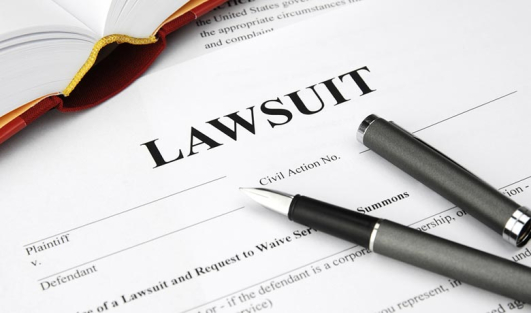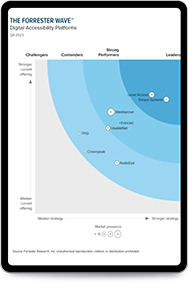Web Accessibility Lawsuits: What’s the Current Landscape?
Apr 20, 2021
Summary: We break down the state of web accessibility lawsuits in 2021: whether the suits hold merit, how defendants have fared, and 4 ways to reduce organizational risk of a web accessibility lawsuit.

The number of web accessibility lawsuits continues to steadily rise in early 2021. General trends show an increase in lawsuits filed in federal courts and state courts. While state court data is unreliable due to reporting constraints, all signs indicate a surge in state court filings in recent years, namely in California and New York.
Demand letter and private settlement numbers are unknown but loom large because demand letters are usually a precursor to filing a lawsuit. This means digital accessibility claims are usually settled privately.
In U.S. federal court, lawsuit claims are overwhelmingly ADA Title III claims. In state court, claims are usually made using local anti-discrimination laws that run parallel to the ADA such as the Unruh Act in California and the New York State / City Human Rights Law in New York.
If you have received a demand letter or lawsuit, eSSENTIAL Accessibility can help.
Many clients partner with eSSENTIAL after receiving a demand letter or lawsuit because we provide 1) technical expertise to make digital assets accessible and 2) legal support. Our legal support can be a tremendous to your counsel because we can assess the veracity of the claims made and provide documentation for your counsel.
Web Accessibility Lawsuits in the U.S.
In 2020, according to research by Seyfarth Shaw, the total number of ADA Title III lawsuits nearly match 2019 record numbers despite COVID-19, with 10,982 suits filed in federal court, down only 1% from 2019’s 11,053 lawsuits filed.
The U.S. Court of Appeals for the Ninth Circuit ruling which reversed a federal judge’s 2017 dismissal of a case against Domino’s Pizza has kept Ninth Circuit courts (i.e., California) as a plaintiff friendly jurisdiction. A man who is blind complained that he was unable to use Domino’s website or mobile app because neither was accessible.
In 2021, the Eleventh Circuit ruled in the opposite direction in the Gil v. Winn-Dixie appeal, holding generally that a website’s accessibility does not give rise to a potential violation of the ADA. While notable, this decision is not nearly impactful on the legal landscape because it happened in the 11th Circuit (Florida, Georgia, and Alabama) and not the Ninth (California) or Second (New York).
Over the years, web accessibility lawsuits have also been filed under Section 508 of the Rehabilitation Act . Section 508 requires federal departments and agencies to ensure ICT (information and communication technology) they use is accessible. Plaintiffs have taken legal action against both the Social Security Administration and the Department of Homeland Security over Section 508 violations.
Are These Lawsuits “Frivolous”?
You may have heard companies or politicians talk about ADA lawsuit “abuse” and “drive-by” litigation, or make claims that this kind of litigation is “frivolous.”
Some plaintiffs are serial litigants but there are others who are genuine in their claims.
For example, San Francisco’s LightHouse for the Blind and Visually Impaired filed a lawsuit against payroll processing and HR company, ADP for a lack of accessibility in its website and mobile app.
Regardless of who files the lawsuits, there is a real need for accessibility in the digital world.
Whether it’s software, documents, websites, mobile apps, or other mediums, if accessibility is ignored, people with disabilities are negatively impacted. The impact can range from a suboptimal experience to outright being prevented or excluded from use.
How Have the Defendants Fared?
The Department of Justice (DOJ) is the governmental agency that regulates and enforces Title II and Title III of the ADA and the DOJ has made it clear that the department’s stance is ADA compliance requires web accessibility. Prior to the Trump administration taking office, the DOJ was fairly active in web accessibility cases, entering into multiple settlements and consent decrees against private companies – and even filing statements of interest in private lawsuits.
Here are some of the organizations the DOJ took action against:
- HR Block
- edX
- Peapod
- Miami University
- McLennan County
- Carnival Cruise Line
- National Museum of Crime and Punishment
- Quik Trip
In all these cases WCAG 2.0, Level AA conformance has been mandated (in some cases the conformance level was left out but it’s very likely the DOJ meant AA conformance).
In 2017, the first web accessibility ADA lawsuit concerning went to a full federal trial. Juan Carlos Gil, who has a vision disability, sued supermarket chain Winn-Dixie because screen-readers wouldn’t work with their website and won.
In 2016 in California, Bag’n Baggage paid $4,000 in damages to a plaintiff who wasn’t able to shop independently on the company’s website. The business, which violated the Unruh Civil Rights Act, also had to remove the web barriers. In 2018, a woman who is blind sued the Whisper Restaurant and Lounge in Los Angeles because she couldn’t read the menu or make a reservation online.
Although there have been only a handful of trial decisions on the merits, court rulings have overwhelmingly favored plaintiffs.
What Can We Expect Going Forward?
As we previously wrote, we do expect the DOJ under the Biden administration to resume digital accessibility activity.
Moreover, we’re already reading more and more plaintiffs citing to WCAG 2.1 AA (the current technical standard with more mobile considerations) rather than 2.0 AA (the standard published in 2008).
At eSSENTIAL, we already recommend and implement WCAG 2.1 AA into our audits.
Relatedly, we expect more litigation involving mobile apps and mobile web experiences.
Although no formal federal prescription for digital accessibility for private entity exists, U.S. authorities have said digital accessibility is mandatory.
In the fall of 2018, the assistant attorney general at the DOJ reaffirmed that the ADA covers websites when writing: “The Department first articulated its interpretation that the ADA applies to public accommodations’ websites over 20 years ago. This interpretation is consistent with the ADA’s title III requirement that the goods, services, privileges, or activities provided by places of public accommodation be equally accessible to people with disabilities.”
Additionally, we do expect DOJ regulation or an amendment to the ADA sometime prior to 2025.
4 Ways to Reduce Your Risk of a Web Accessibility Lawsuit
- Conform with WCAG 2.1 AA standards. If your digital assets conform to WCAG 2.1 AA, you will greatly reduce your risk of digital accessibility litigation. Even better, people with disabilities who visit your websites will feel welcomed — and will be able to interact online with ease.
- If you are unsure of your WCAG conformance, evaluate your current state of accessibility. First scan your website for accessibility errors. Automated scanners can detect about 30 percent of WCAG success criteria. Next, engage an expert to perform a comprehensive audit of your website. This audit will include key findings from an automated scan as well as results of a manual evaluation, including evaluation conducted by people with disabilities. This testing will help identify accessibility errors that automation on its own can’t find (the remaining 70 percent of WCAG success criterial).
- Address any barriers identified. Prioritize fixing the most critical errors on your high-visibility pages. For example, start with errors on your homepage, your other primary pages, and your main user flows.
- Create a roadmap for ongoing monitoring, evaluation, and remediation. Web content is dynamic. While you may conform with WCAG criteria one day, adding additional content may inadvertently add additional barriers. Ensure you have the most effective partner to help you continuously monitor your accessibility and fix new issues that may be introduced.
[irp posts=”1331″ name=”Web Accessibility Standards, Guidelines, Laws and Compliance”]
An Innovative Solution
eSSENTIAL Accessibility has developed a comprehensive accessibility solution to help organizations follow best practices for ADA compliance. If you haven’t already, your organization can start removing barriers with our interactive WCAG 2.1 checklist available for download today.
Schedule a demo or contact us to learn more about how we can help.
Subscribe for updates

